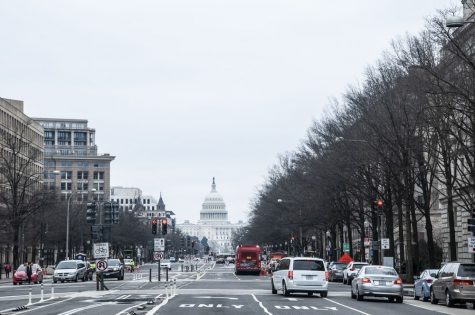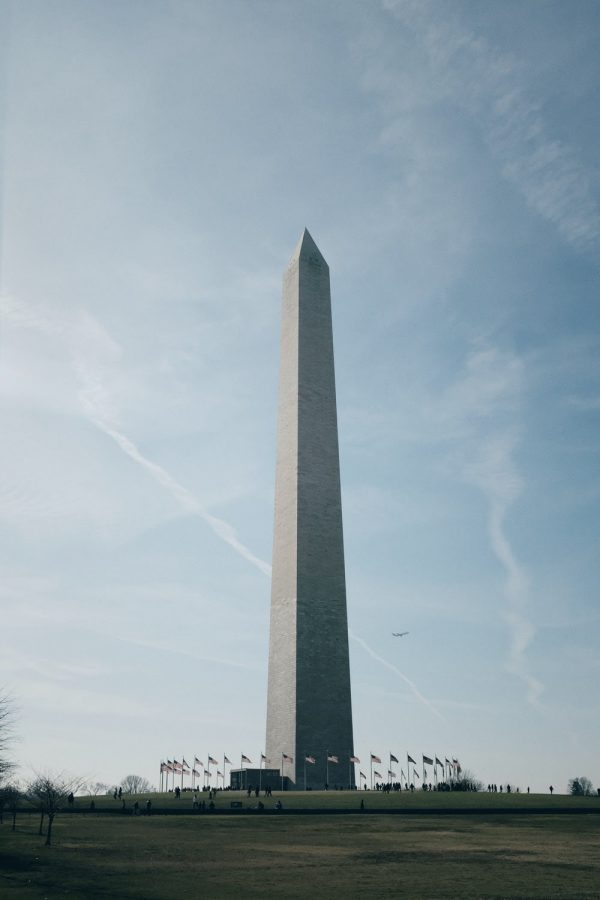Washington D.C. as the 51st State
Following the events of January 6th, 2021, Washington D.C.’s quest for statehood has been thrust back into the public eye.
The Washington monument, an iconic symbol of the capitol, stands surrounded by flags and visitors in the morning.
Since its creation, Washington, D.C. has found itself in a strange and unique position. While it has a larger population than Wyoming and Vermont, the District has been excluded from statehood for a myriad of reasons. In recent decades, however, there has been a push from city politicians to rectify that and establish it as the 51st state of America.
When, for the first time in history, this push finally made it to the Senate towards the end of 2020, the Senate acted as an insurmountable brick wall blocking statehood. Even though the initiative was gaining ground, it was believed that it would still take years (if not decades) before Washington, D.C. would become a state. Then the January 6th, 2021 insurrection happened.
The insurrection immediately dominated the news, as pundits and viewers questioned not only former president Donald Trump’s role in the riot, but also how the Capitol Hill police could allow such a thing to happen. Many quickly pointed out that in June 2020, nonviolent Black Lives Matter protesters were constantly confronted with much more security than the violent insurrectionists.
The lack of reinforcements or sufficient preparations for Capitol Hill police officers, a massive departure from the response to BLM protests in June, reawakened the statehood debate in a big way. One of the major arguments against statehood for the District of Columbia is that it would give control over the Capitol’s security — which should be nonpartisan — to political agents such as governors and state legislators.
Washington D.C.’s mayor, Muriel Bowser, has led the push in recent years for D.C. to be granted statehood. On the day of the insurrection, she asked for federal reinforcements only to have her request denied, which for her and other elected officials reaffirmed the belief that they have very little control over what happens in their city. This belief once again comes back to the deployment of federal troops this past summer, which occurred despite opposition from D.C. leaders.

Legislators from D.C. like Representative Norton have also proposed plans that would maintain the autonomy of areas like the Capitol building, the White House, and different national monuments while separating the city itself into 8 districts. This would avoid questions of security but not questions of partisanship that have been levied by Republicans; they argue that adding a new state in a predominately blue area would skew power to the Democratic Party in the House of Representatives and Senate. For many, the debate largely comes down to the question of representation versus balance in the chambers of Congress. Kristof Jablonowski ’22 said, “In my opinion, trying to pass D.C. as a state is an attempt by the Democratic party to gain two seats in the Senate.” Jablonowski added, “If it were left to me, and voter turnout was so important, then the residential area of DC should be retroceded back to Mayland. Then they would be represented in Congress.”
The representational ramifications for Congress have provoked broad national debate. Theodore (Teddie) Wai ’21 said, “Anyone who is taxed without representation has the right to fight for their rights. However, this is certainly a divisive issue. I think this should be left to a broader national conversation.”
The question will ultimately be up to the House of Representatives and Senate, where Democratic senator Tom Carper of Delaware has already introduced a bill to make D.C. the 51st state. The bill is poised to have overwhelming support from the party. There are still two major hurdles, however, which could slow down or stop the Democrats’ effort altogether.
The first comes within the party itself — the Senate is technically 50 – 50, meaning there is no leeway, and that the most moderate Senators, like West Virginia’s Joe Manchin, could be swing votes. Senator Manchin, a famous “conservative Democrat,” has stressed bipartisanship and keeping the party close to the political center, meaning that he could effectively stop the passage of a bill involving statehood.
The second much greater issue is the legislative filibuster. Passing the bill past the filibuster would require 60 votes, which is almost impossible, as the Republicans are unified in their support against inducting D.C. as the 51st state. That means that in order to achieve D.C. statehood, Democrats would need to eliminate the legislative filibuster, which would undercut President Biden’s push for bipartisanship and cross-party cooperation.
In early 2021, the District of Columbia returned to the public eye in its bid for statehood, sparking debates about representation, security, and partisanship. While the district has never been as close to becoming a state as it is right now, major roadblocks still hold it back.
On Monday, March 22nd, 2o21, reporter Emily Cochrane from The New York Times, reported that “House Democrats put new weight on Monday [March 22nd, 2021] behind their push to grant statehood to Washington, D.C., convening a key House panel to make the case in the latest sign that the long-suffering movement has shifted from the political fringe to the center of the party’s voting rights agenda.”
Gaining statehood could mean a major change for America, altering the political landscape permanently, and in the future could even be viewed as one of the Biden administration’s most significant moves — only time will tell.
“Anyone who is taxed without representation has the right to fight for their rights,” said Theodore (Teddie) Wai ’21.
Declan Hilfers is an Editor-in-Chief and Staff Reporter for ‘The Science Survey.’ He is attracted to journalism because it presents an outlet to bring...

